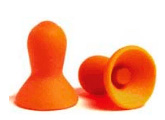Hearing Protective Equipment
Last Updated: September 21, 2020 6:11:35 PM PDT
Give feedback
Find out who should wear hearing protective equipment, the different types of equipment available, and how it may be accessed.
Hearing protective equipment protects the ear from injury and prevents hearing loss.
Requirement for supervisors
Supervisors are required to assess the workplace to determine if hazards are present or likely to be present that necessitate the use of PPE, provide employees with appropriate PPE and training, and require them to use and maintain it. See Personal Protective Equipment for details.
Departments are responsible for:
- Providing hearing protective equipment to:
- Employees who are exposed to noise at or above 85 dB(A) averaged out over an 8-hour workday — the same limit required for enrollment in the Hearing Conservation Program
- Anyone who enters an area designated as "hearing protection required"
- Paying for the hearing protectors
- Replacing hearing protectors if they are broken, defective, or unsanitary
- Giving employees a choice between at least 2 brands of hearing protectors
Types of hearing protectors
Several types of hearing protectors are available, offering protection for varying degrees of noise exposure.
 Aural protectors, sometimes called inserts, are plug-type protectors placed directly into the ear canal. There are several types, and most are available from procurement:
Aural protectors, sometimes called inserts, are plug-type protectors placed directly into the ear canal. There are several types, and most are available from procurement:
- Pre-molded (sized or universal)
- Moldable (usually made of foam)
- Custom molded (available from an audiologist)
- Circumaural protectors (muffs) are plastic domes that cover the ears and are connected with a spring band that fits on top of the head.
- Superaural protectors (canal caps) seal the external opening to the ear canal. Audiologists fit and order canal caps.
Contact EH&S Occupational Health & Hygiene Services at ehsih@ucsd.edu for guidance on selection and use of hearing protection.
Questions? Contact EH&S Occupational Health & Hygiene Services at ehsih@ucsd.edu.